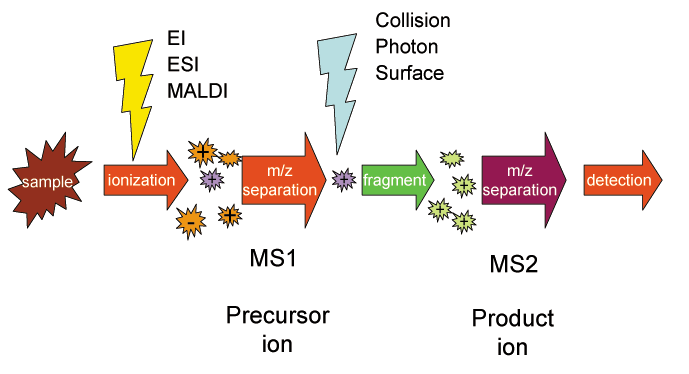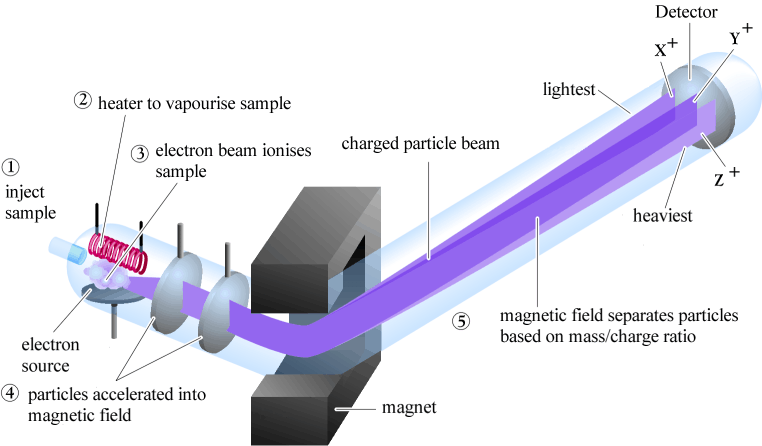Mass Spectometry
Key Questions
-
Answer:
Mass spectrometers are used in almost every area of science.
Explanation:
Here are a few examples.
Archeology
- Carbon dating
Biology and Biotechnology
- Identifying structures of complex molecules such as peptides and proteins
Earth Science
- Measuring petroleum precursors in rock
Environmental Science
- Monitoring toxins in animals and fish
- Monitoring atmospheric, water, and soil contaminants
- Monitoring food contaminants
Forensics
- Analysis of poisons or toxins in body tissues
- Analysis of trace evidence such as carpet fibres, paint flakes, etc.
- Identification of accelerants used by arsonists
- Identification of explosive residue from bombings
- Testing for traces of chemicals likely to be used by terrorists
Medicine
- Monitoring the respiratory gases of patients under anesthesia
- Neonatal screening
- Hemoglobin analysis
Paleontology
- Radioactive dating
Pharmaceutical Industry
- Characterization of new drugs
- Identifying impurities in drugs
- Studies of drug metabolism
Space Exploration
- Analysis of the solar wind
- Analysis of planetary soil and atmosphere
- Monitoring air quality and composition in space shuttles
Sports Medicine
- Testing for the presence of steroids, diuretics, and stimulants in a person's body
-
One benefit of multiple mass spectrometers in a row allows for more precise identification of molecules with very similar masses, such as
#"135.220 g/mol"# vs.#"135.212 g/mol"# .It also helps distinguish between molecules of similar masses based on their structure, since it improves the amount of fragmentation that occurs, and hence, extends the fragmentation pattern. Extend it enough, and you can notice small differences that may tell you the differences between two very similar structures.
The steps to tandem mass spec (MS/MS) are:

- MS #1: Load sample
-
MS #1: Ionize sample using such techniques as electron "impact" (interaction; EI), electrospray ionization (ESI), and matrix-absorption laser desorption ionization (MALDI).
- EI --- Fire an electron beam to knock off an electron, ionizing the sample. This results in a hard ionization, which may make it difficult to spot the original parent peak fragments into daughter peaks.
- ESI --- Electrically charged droplets of sample progressively get overloaded with such charge and then they become an aerosol. This results in soft ionization, which minimizes unwanted fragmentation and makes it easier to spot the original parent peak.
- MALDI --- A suitable matrix material shields the sample from a pulsed laser, taking the brunt of the ionization, and then ionizes the sample, causing a soft ionization.
-
MS #1: Separate ions of specific mass-to-charge ratios, with for example, flight chambers, a quadrupole ion trap, quadrupole filter, etc.
These essentially use electric and/or magnetic fields to induce motion, separating samples based on mass or charge or both.
- MS #1: Fragment sample. Tends to be done using collisions with neutral molecules for MS/MS.
- MS #2: Separate ions of specific mass-to-charge ratios, with for example, flight chambers, a quadrupole ion trap, quadrupole filter, etc.
These essentially use electric and/or magnetic fields to induce motion, separating samples based on mass or charge or both.
- MS #2: Detection of sample. You may see detectors like Faraday plates, Photomultiplier tubes, etc.
These essentially just count the number of ion-collisions onto their surface. Then some sort of transducer converts the number into an electrical signal that tells the computer what the abundance of ions is. The mass spectrum is plotted based on that, with abundance vs. m/z ratio.
-

Mass Spectroscopy (MS), in the most basic sense, is for tracing the fragmentation patterns of molecular ions in order to identify them. This tends to be more useful when coupled with other processes, such as Gas Chromatography and Liquid Chromatography.
MS has an interesting process by which we do the following (in a vacuum):
- Inject liquid sample (might be a few
#muL# if you are injecting into a GC-MS setup; depends on the injection method) - Vaporize sample (must be a gas to minimize undesirable fragmentation)
- Ionize sample (must be an ion to interact with electric/magnetic fields) to facilitate fragmentation
- Accelerate fragments into field (electric and/or magnetic) to separate ions by
#m/z# ratio - Detect the ions to get a count for the abundance of each ion
- Acquire mass spectrum
This is the essential process of Mass Spectroscopy.
In further depth:
Inject the sample via some method, such as the 30-ft long tube you use in Gas Chromatography (i.e. the GC is interfaced with MS and you have a GC-MS setup), for example.
Some sort of sample vaporization occurs so that you have a gaseous sample. This may be done with, perhaps, a coil with electric current flowing through it, or maybe a hot flame (
#> 3000 K# or so), for example.Some sort of ionization occurs (which facilitates fragmentation), such as:
- Chemical Ionization (soft/indirect ionization via the presence of ions in the system)
- Matrix-Assisted Laser-Desorption Ionization (a sample matrix is hit with a laser, ionized, and the matrix itself soft-ionizes the sample embedded within and shielded by the matrix)
- Electron "Impact", where an electron beam allows electrons to interact with the sample to knock off an electron and thus ionize it (hard ionization).
The point of having both soft and hard ionization is that soft ionization better-retains the parent peak during fragmentation, so that you can find the peak that corresponds to the molecular mass of the original ion.
The fragments are then accelerated into an electric and/or magnetic field for the purpose of separating it by a mass-to-charge ratio,
#m"/"z# . The ions then separate and then spiral towards some sort of collection surface that counts ions. This separation may be done with, for example, a quadrupole filter ("quadrupole" literally means "four [magnetic] poles").The ions must reach a detector, such as a Faraday Plate or Faraday Cup. Behind it would be some sort of transducer to convert/encode the number of ions that are counted into a current that acts as a signal for a computer to read, so that it can generate some sort of display to give you your mass spectrum.
- Inject liquid sample (might be a few